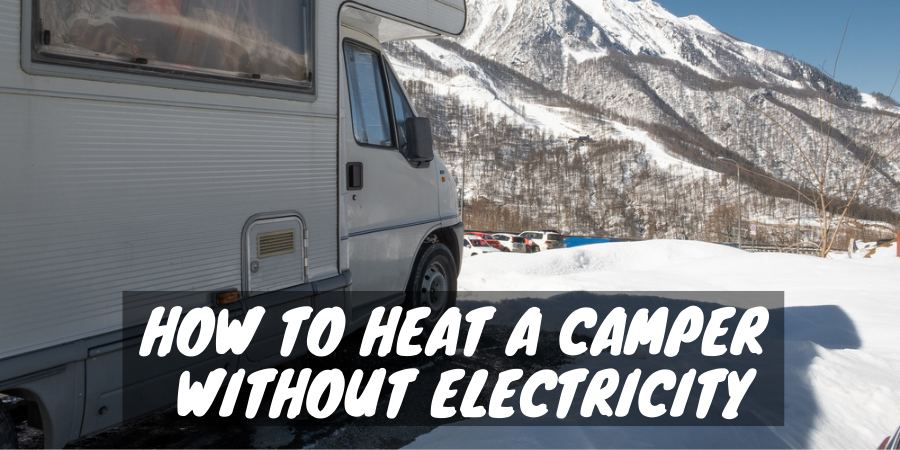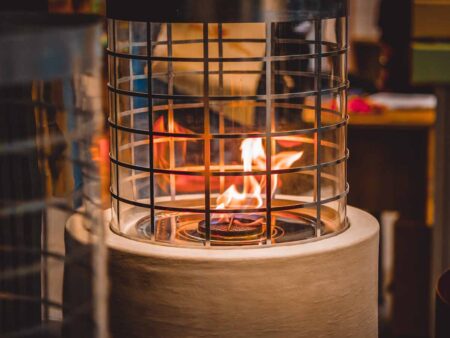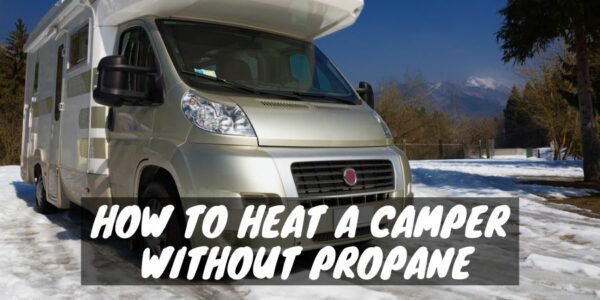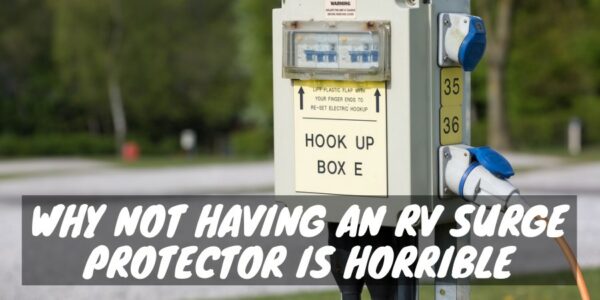Cool-weather camping without electricity doesn’t mean you have to put up with the cold.
There are many options to heat a camper when you don’t have electricity to run a space heater, and you’ll find them all right here.
If you love to boondock, or the power goes out at your campground, knowing your options to stay warm in your RV without electricity can be a real lifesaver, so let’s explore all the details!
The Best Ways to Heat Your Camper Without Electricity
Run the Camper’s Propane Furnace
Many RVs and travel trailers come with a propane furnace system that works off 20 or 30-pound propane-gas tanks.
While a propane furnace does require power to light the burner and blow the fan, the small amount of energy it needs can come from the camper’s auxiliary 12V battery bank.
Full Moon Adventure Club put out the following informative video to determine how long a battery can run an RV propane furnace.
What they found was you can expect around 11 hours of run-time for a propane furnace off of one RV battery with a full charge when you set the temperature to 65° F.
Of course, without a way to recharge your house battery to keep the furnace running, you will have to look into a solar panel charge attachment, take a short camping trip, or opt for a freestanding heating solution.
Install a Wood Stove to Heat Your Camper
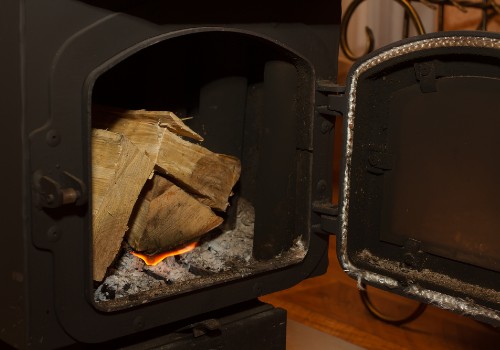
Many RVers find the addition of a wood stove in their camper to be the answer to heating without electricity.
There are plenty of wood stoves for RV or campers that are safe and effective when you install and vent them properly.
With wood being the only fuel, you can bring some along or score free branches at your campsite to stay warm in your camper.
There are many benefits to wood stove heating that may sway your thinking about this option, including:
- The heat creates little humidity, which stops drippy window or ceiling condensation
- Fuel is cheap or free
- Heat output is high and easy to control
- Stoves with large tops double as a cooktop
- You can add different wood to make the camper smell nice
A wood stove is a reliable and safe source of heat that requires no electricity to operate for those who work full-time in cold climates or who love to camp year-round.
Use a Portable Propane Heater in the RV
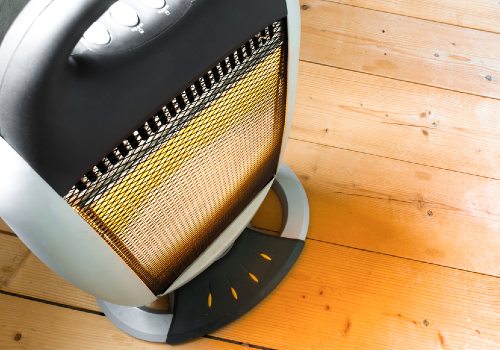
How to keep your camper warm in winter without electricity is to use a portable propane heater. These units, such as Mr. Buddy models, are safe for indoor camper use when you use a few precautionary measures.
Most propane heaters use the small 1-pound screw-in style tanks that also work for camping grills or lanterns. These canisters are inexpensive and can run a heater for four to six hours.
Some portable RV heaters may run on a butane canister instead of a propane version. Butane canisters are typically smaller and, therefore, less commonplace for RV heating use.
You can find propane camper heaters that also adapt to run off a 20-pound or larger propane tank, so you don’t have to monitor the heater’s fuel level as often.
A portable gas heater is a must-have piece of equipment for any camper. You never know what emergency may arise where you end up boondocking or find the power goes out at your campsite.
You can also use more than one if your camper is large to heat all the space evenly.
If you plan to use a portable propane or butane-fuel heater for your camper, please follow these safety guidelines:
- Install a carbon monoxide detector in your RV
- Make sure your unit has a UL label
- Keep pets and kids away from the unit
- Get a unit with automatic shut-off sensors for low-oxygen, tipovers, or excessive heat
- Never place the heater near flammable materials
- Do not use air fresheners or sprays during operation
- Between uses, remove dust build-up from the unit
- Follow all manufacturer’s instructions
- Never leave the unit unattended
Install a Vented Furnace in Your Camper
For conversion vans or motorhomes, another option for electric-free heating is to install a vented furnace, such as the Espar (Eberspacher) air heater system.
The system works by using an oil tank and your vehicle’s diesel gas tank to fuel the system for heat.
These units intake fresh air from outside your camper and safely exhaust fuel fumes to the outside using venting.
The benefit of a vented furnace is that it doesn’t emit harmful carbon dioxide inside your camper (with proper installation), so you can sleep soundly.
Another perk is that you mount the system permanently, and it will operate off a thermostat. Just turn it on, set it to temperature, and forget about it.
On the downside, the system parts and professional installation may be costly. You’ll also need a battery bank in your camper to support the power necessary to run the ignitor, thermostat, and fans.
Use a Solar Heating System
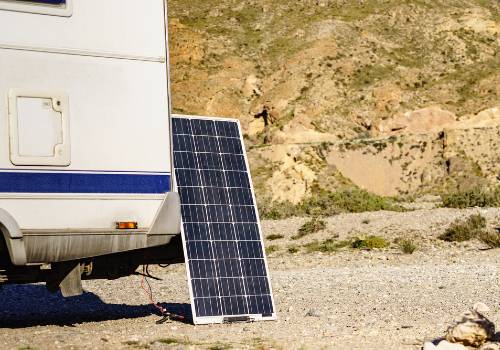
Small heaters that run off solar power are another option for boondocking or dry camping when electricity is not available.
If off-grid camping will be high on your list of camping destinations, setting up and installing a powerful solar array on your camper is probably a good idea and worth the investment.
Once you have all the infrastructure in place, you can efficiently heat your camper using the battery bank’s power.
For stationary campers, you can also look into building a solar heating box. These boxes sit outside your RV or fit into a window and will heat your camper’s interior passively without electricity.
There are many plans for DIY solar heat boxes available online, but my two favorites are the heat grabber from Mother Earth News and a portable one in the following video.
Portable Solar Heater for Your RV (Video)
Alternatives to Keep Your Camper Warm in Winter
All the above options are great for consistent heat when you need it often, but what about those occasional chilly nights you may encounter?
The answer is to consider these alternatives to keep you toasty while camping.
Choose Warm Camping Locations
If you want to stay warm while camping, opt for warmer locations that won’t require the use of a heating system.
Southern and western regions offer an abundance of camping options that may have you putting on a sweatshirt but won’t require the use of a heater to ward off the chill.
Full-time RVers who enjoy temperate weather move about seasonally to places that offer the best climate that requires no heating or cooling to stay comfortable. You may find them in South Florida during winter, southern California in spring, Maine in the summer, and North Carolina in the fall.
Use your Motorhome or Tow Vehicle’s Heater
In a pinch, you can run your motorhome’s engine and use the dashboard heater to warm your camper if all else fails.
You can also abandon the camper and jump into your running tow vehicle to warm up when the temperatures dip too low for comfort.
Do watch out for carbon monoxide inside the vehicle or motorhome, so crack a window to let in the fresh air.
Use Flameless Heater Packets to Warm Your Camper Bed
When sitting on the couch or sleeping, you may need a bit of heat to stay comfortable, and packet heaters are a cheap way to warm those toes.
From the small pouches made for boots or gloves to larger ones made for inside shirts or even cooking, you can use them to get through the spurts of cold temperatures without spending a lot of money on a central heating system.
The small hand warmer packets provide warming for up to 13 hours, while larger ones can generate heat above 100° F in ten minutes for quick warmth.
Want to Connect With a Community of Over 1,078 RV Enthusiasts?
All of these packets rely on a chemical reaction to create heat. Some activate with air, while others activate with water, such as those made for cooking ready-to-eat meals.
I have put the packets for food cooking to use as a general heating pad, and as long as you wrap the packet loosely in a t-shirt to protect against burns, it works wonderfully to warm up your bed when you don’t have electricity.
If any possible off-gases or water leakage from MRE heater packets scare you away, consider battery-operated heating pads or blankets.
Use Battery-Operated Blankets to Warm You In Your Camper
The Cozy blanket is one of the best on the market and allows you to stay warm for up to six hours on one charge.
The battery pack is rechargeable, which is a plus, as you can use a generator with a USB port or your vehicle to recharge it between uses.
Ways to Improve Your Camper’s Insulation to Retain Heat
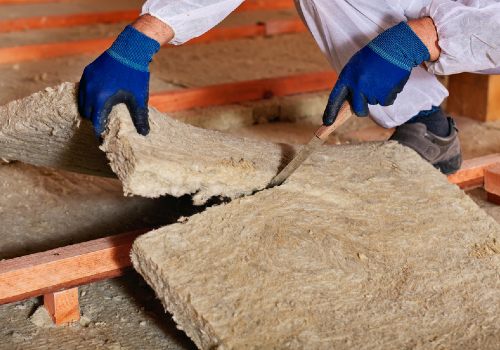
Keeping heat inside your camper is not always easy with the thin walls and poor insulation common to RV builds.
Add Insulation
Luckily, the easiest way to add insulation to stay warmer in cold weather is to purchase some Reflectix.
Most campers use this insulating material to cover windows, walls, or ceilings where heat escapes.
This material looks like bubble wrap with a thin, shiny coating and is available in rolls at home improvement stores.
This material does wonders to insulate a camper to retain or reflect heat as necessary for such an affordable price.
Make templates of your camper windows and cut pieces of the insulation about 1/8-inch larger all around. By making the size just a bit larger, you can pop them into the window, and they will hold themselves in place without the need to use tape.
You can also roll out sections to cover your ceiling to keep in the heat. The material is super lightweight and holds up with painter’s tape, so you aren’t damaging your camper walls.
When you don’t need it, you can roll it up tightly or lay it in flat sheets under bedding or camper seats for storage.
Hang Blankets
If you’re caught off-guard on cold days, even hanging blankets in front of windows can block heat loss, as the single-pane glass in most campers has little insulating value.
Hanging a blanket over the cab area of a motorhome is another trick to keep the cold air from coming into the main cabin.
The cab has the largest glass expanse area, so it makes sense to double buffer this zone by adding Reflectix directly to the windows and then hanging a blanket across the opening.
Use Rugs and Curtains
Covering wood, tile, or laminate flooring with area rugs will help warm feet and create another barrier to retain heat within the camper’s cabin.
Curtains drawn around beds will warm the space from your body heat alone.
Bed tents are another option if you have space, which can keep heat right where you want it and help you sleep through chilly nights.
"Man cannot discover new oceans unless he has the courage to lose sight of the shore."
-- Andre Gide

